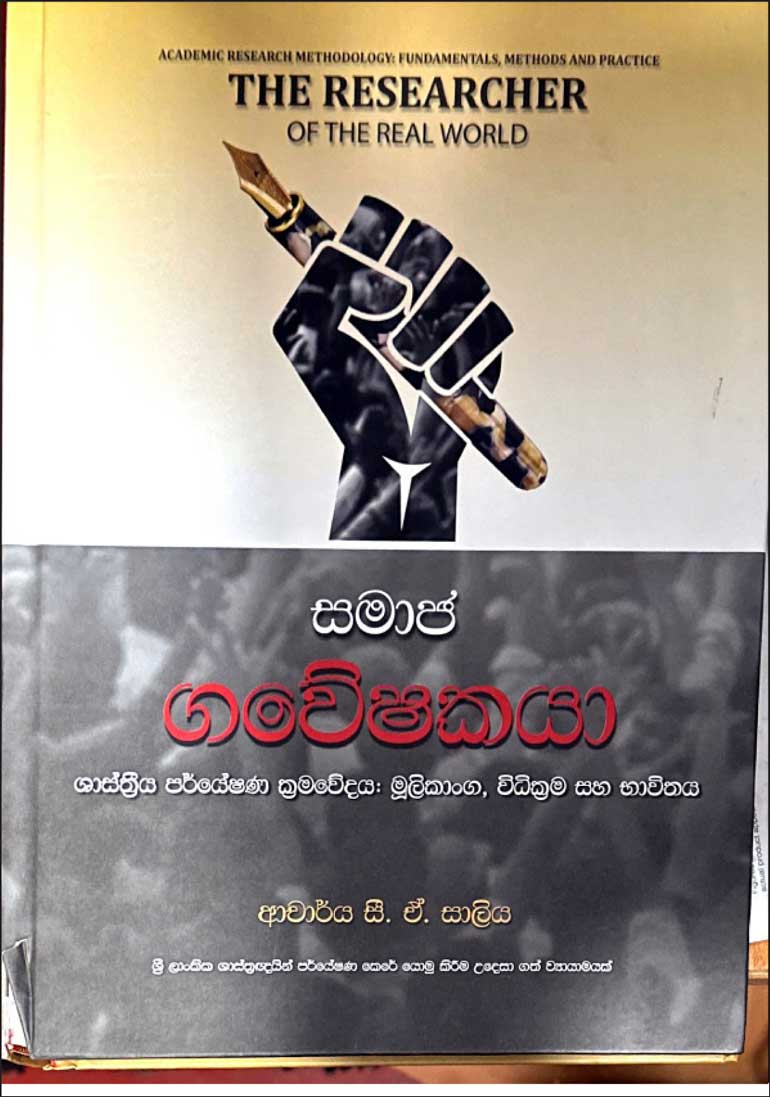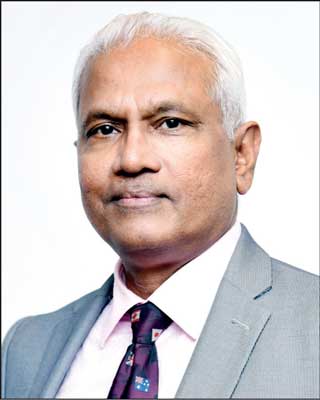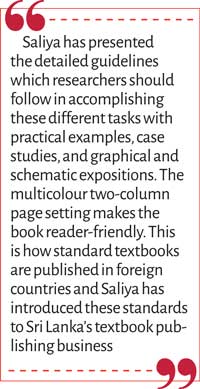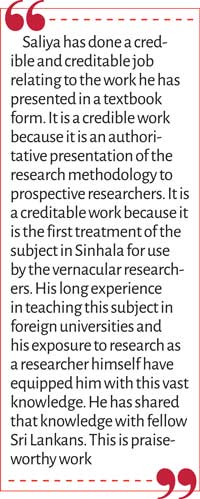Friday Dec 26, 2025
Friday Dec 26, 2025
Monday, 22 May 2023 00:05 - - {{hitsCtrl.values.hits}}

in Sinhala
 Prof. C.A. Saliya, presently at the Sri Lanka Institute of Information Technology and previously in several foreign universities including the Fiji National University, AUT University in New Zealand, and the Southern Queensland University in Australia, has accomplished the impossible task of making research methodology easily accessible to Sri Lankan researchers.
Prof. C.A. Saliya, presently at the Sri Lanka Institute of Information Technology and previously in several foreign universities including the Fiji National University, AUT University in New Zealand, and the Southern Queensland University in Australia, has accomplished the impossible task of making research methodology easily accessible to Sri Lankan researchers.
The book he has released, mostly in Sinhala and all-important areas in English as well, under the title ‘The Researcher of the Real World – Academic Research Methodology: Fundamentals, Methods and Practice’ is the first comprehensive treatment of the subject in Sinhala that can be used as a ready reckoner by vernacular researchers in the country. This, in my view, amounts to filling of a long-felt gap from the point of the Sri Lankan researchers.
Introducing high standards in textbook publishing
The book containing 528 pages of the standard textbook size has been presented in 5 parts of 30 chapters. It starts from a very fundamental level, goes into rigorous treatment, and finishes with advice to researchers on how they should publish their papers in peer reviewed high ranked journals. Research is necessarily a chain of action by the researcher, to be completed one after the other and in some cases simultaneously. Saliya has presented the detailed guidelines which researchers should follow in accomplishing these different tasks with practical examples, case studies, and graphical and schematic expositions. The multicolour two-column page setting makes the book reader-friendly. This is how standard textbooks are published in foreign countries and Saliya has introduced these standards to Sri Lanka’s textbook publishing business.
Use of the most appropriate Sinhala terms
 |
| Prof. C.A. Saliya |
His suggestion has been not to make a direct translation of the English term but its use in the context of the subject under review in a broader sense. For instance, the literature review, an essential component of any scientific research, intends to present to the reader in summary form the findings by the previous researchers on the subject under consideration. It  is also a demonstration of the awareness of the researcher of the works done by the previous researchers. Hence, it is necessary to understand such work more clearly in the first place, known as cognition, and then, take it into one’s system, known as perception. Saliya says that a beginner of a researcher should be fully conversant of this essential requirement.
is also a demonstration of the awareness of the researcher of the works done by the previous researchers. Hence, it is necessary to understand such work more clearly in the first place, known as cognition, and then, take it into one’s system, known as perception. Saliya says that a beginner of a researcher should be fully conversant of this essential requirement.
Even a roadside mechanic is a scientist
Several chapters of the book have been devoted to informing the prospective researchers of the methodological issues that they may encounter while conducting their research. Scientific research involves following a set procedure like making a hypothesis, deciding on the procedure, collection of data, analysis, and confirmation or the rejection of the hypothesis. The American philosopher Robert Pirsig in his Zen and the Art of Motorcycle Maintenance, a fictional exposition of Western scientific methodology, has said that even a sideway motorcycle mechanic is a scientist following this procedure when it comes to diagnosing the problem with a machine. Hence, research methodology is not confined only to those who conduct research in laboratories. It is being followed by ordinary people in their day-to-day events.
Consider the procedure followed by a typical housewife in certifying a curry she is cooking is in line with the taste requirements of the diner involved. She, after putting the ingredients in correct quantities, will test samples of the curry continuously, assess its acceptability, changes the composition of ingredients as necessary, and makes the final judgment that the curry in question meets the requirements. If it does not meet the requirements, she will simply throw the curry away.
 These methodological issues have been lucidly described by Saliya providing detailed descriptions of historical developments, present state, and pros and cons of each approach. Drawing on his long experience and the mastery of the language, Saliya has chosen the most appropriate Sinhala term to present these methodologies at times disputing the Sinhala term used by other writers for specific English terms.
These methodological issues have been lucidly described by Saliya providing detailed descriptions of historical developments, present state, and pros and cons of each approach. Drawing on his long experience and the mastery of the language, Saliya has chosen the most appropriate Sinhala term to present these methodologies at times disputing the Sinhala term used by other writers for specific English terms.
Impact factor in research
Sri Lankan universities are ranked very low in global ranking of higher learning institutions. One of the reasons for such low ranking is the low incidence of publishing research papers in peer reviewed high ranked journals or books. In a sideway comment in English, this has been described by Saliya as follows: ‘Publish or perish is an aphorism describing the pressure to publish academic work in order to succeed in an academic career. Such institutional pressure is generally strongest at research universities. Successful publications bring attention to scholars and their sponsoring institutions, which can help continued funding and their careers. In popular academic perception, scholars who publish infrequently, or who do not focus on activities that do not result in publications, such as instructing undergraduates, may lose ground in competition for available tenure track positions. The value of the published work is often determined by the prestige of academic journal it is published in. Journals can be measured by their impact factor (IF), which is the average number of citations to articles published in a particular journal’.
This explains what action should be taken by Sri Lankan universities to earn higher ranking among the global universities. The number of citations which a scholar can get as stored in indexed data bases like Scopus, Pro-quest, or Science Direct will increase the impact factor as well as the prestige of the universities which they are serving. Hence, to gain recognition and promote Sri Lanka as an educational hub, the country’s higher education authorities should give every encouragement to local academics to conduct research and publish the results in high ranked journals. There should be accelerated career advancement system for those who earn the highest in ranking, citations, and references which can be objectively measured.
Both quantitative and qualitative studies are equally valid
 The methodology adopted in research can be quantitative involving the measurement of precise values, descriptive where the chain of arguments is developed by verbal methods, or a mixture of both in which the quantitative and descriptive methods are adopted in different proportions. Saliya, while describing each method, has correctly concluded that none of the methods is ranked superior to the other. It all depends on the formulation of the research question appropriately. Quantitative researchers tend to believe that formulating the research question is superfluous and inappropriate. But the descriptive researchers who are also called the qualitative researchers believe that formulating it is a necessary step to be taken by a researcher.
The methodology adopted in research can be quantitative involving the measurement of precise values, descriptive where the chain of arguments is developed by verbal methods, or a mixture of both in which the quantitative and descriptive methods are adopted in different proportions. Saliya, while describing each method, has correctly concluded that none of the methods is ranked superior to the other. It all depends on the formulation of the research question appropriately. Quantitative researchers tend to believe that formulating the research question is superfluous and inappropriate. But the descriptive researchers who are also called the qualitative researchers believe that formulating it is a necessary step to be taken by a researcher.
Describing how the problem statement should be formulated, Saliya says: ‘The vital issues addressed in this process are the curiosity, the aspirations and/or goals, appropriate research paradigms or perspectives, researchers’ expertise and experience, accessibility to data, the topic, the context, the issues/questions, the motivation, and the potential relationship that could be explored. Articulating a reasonably acceptable research question could stem from curiosity such as ‘a burning issue’, ‘a mystery’, or ‘nice to know passion’ etc., however, the lucidity of the problem and the objectives largely depend on the process; an interactive exercise through initial investigations, preliminary review of literature, matching with underpinning philosophical stances, and the continuous cross references to the vital issues’.
In essence, a researcher is a person who activates his curiosity into practical testing and presents what he has found either in quantitative form or descriptive form to be understood by all. Higher the level of understanding, greater the citations and references that he could expect from others. Therefore, the technological savviness is necessary, but ability to present what one has found in a language that could be understood by all is the most essential requirement.
CRAP Test in literature review
 The completion of a literature review relating to the problem being investigated is the most challenging part of any research. Saliya has given step by step instructions on how it should be done. This is not simply reference to what other people have done. It involves summarising the main methods and the outcome of the work and presentation of same in the context of the research problem under investigation. Saliya says that the choice of the work to be covered should be subject to what is known as the CRAP Test. It is the abbreviation of four vital terms, Currency, Relevance, Authority, and Purpose. Currency is how recent is the work, relevance is how it is related to the problem, authority is the credibility of the publisher and/or the writer, and purpose is whether the writer in question has attempted to give new knowledge or not. The works that are to be listed in the literature review should pass all these tests.
The completion of a literature review relating to the problem being investigated is the most challenging part of any research. Saliya has given step by step instructions on how it should be done. This is not simply reference to what other people have done. It involves summarising the main methods and the outcome of the work and presentation of same in the context of the research problem under investigation. Saliya says that the choice of the work to be covered should be subject to what is known as the CRAP Test. It is the abbreviation of four vital terms, Currency, Relevance, Authority, and Purpose. Currency is how recent is the work, relevance is how it is related to the problem, authority is the credibility of the publisher and/or the writer, and purpose is whether the writer in question has attempted to give new knowledge or not. The works that are to be listed in the literature review should pass all these tests.
Saliya warns that researchers should not walk into the pitfall of pseudo or false arguments of other writers. There can be research done by others without substantiating the facts with evidence or data or when they are presented, through fake or created data to prove one’s point. These should be excluded from the literature review being done. Kautilya who wrote the first text of economics in the 3rd century BCE – The Arthashastra – referred to the work of the previous philosophers but claimed that their work does not stand the test of applicability at the time of writing his treatise. Hence, to be wary of false claims by others, however much they are popular or known, had been an accepted policy by all undertaking scholarly work from ancient times.
Quantitative techniques in Sinhala
Saliya’s book contains a substantial treatment of the quantitative techniques which modern researchers can use for their research works. In fact, advancements in information technology have made the use of these techniques easy for researchers today. There are ready-made computer programs which are user friendly and can be run by others if they want to test whether the researcher has done his work honestly or not. It has improved the integrity of research works in modern times. Anyone can master these programs by studying the tutorials available on the internet. Though the present work by Saliya is not a standard textbook of statistics and econometrics, he has covered the two subjects adequately for any researcher to further study the same and advance his knowledge.
The usefulness of his analysis is that he has taken his readers through practical application of these techniques by using different statistical packages that are presently used by researchers. However, this is a growing subject and soon his work may be outdated. It is therefore necessary to revise these textbooks periodically to accommodate the new knowledge being developed in the field.
Saliya’s work: A credible and creditable job
In summary, Saliya has done a credible and creditable job relating to the work he has presented in a textbook form. It is a credible work because it is an authoritative presentation of the research methodology to prospective researchers. It is a creditable work because it is the first treatment of the subject in Sinhala for use by the vernacular researchers. His long experience in teaching this subject in foreign universities and his exposure to research as a researcher himself have equipped him with this vast knowledge. He has shared that knowledge with fellow Sri Lankans. This is praiseworthy work.
Modestly priced book
Given the current high printing costs, the book which comes in hard cover for durability and continuous use has been priced modestly at Rs. 9,750 which is about $ 30 at today’s exchange rate. This is a discount for Sri Lankan readers because a book of this calibre published elsewhere is usually priced at about $ 100 to $ 150. It seems that Saliya has not got any royalty out of the book and provided a free service to Sri Lankan researchers by disseminating his knowledge in print form. That is a book which should be kept in every Sri Lankan university library.
I recommend his book to all Sri Lankan researchers.
(The writer, a former Deputy Governor of the Central Bank of Sri Lanka, can be reached at [email protected].)